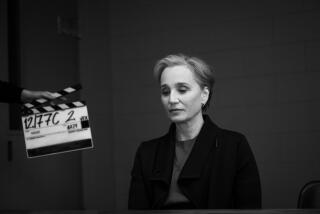From the Archives: Myrna Loy, Star of âThin Manâ Films, Dies at 88
Myrna Loy, whose film career languished when she portrayed exotic vamps but blossomed in the elegant glow she cast as the Thin Manâs loving but acerbic wife, died Tuesday.
Miss Loy, once heralded as âThe Queen of the Movies,â was 88 and died at Lenox Hill Hospital in New York after a lengthy, undisclosed illness. She had been in failing health for several years and was unable to attend the March 25, 1991, Academy Awards ceremony where she was given a special Oscar for her lifetime dedication to motion pictures.
She once was one of Hollywoodâs most beautiful actressesâa sloe-eyed, copper-haired beau ideal whose first film role came about when the legendary Rudolph Valentino saw her at Graumanâs Chinese Theater when that film mecca also featured live entertainment. But for the last five decades she had comfortably adapted to the world of character acting.
âIf you want to stay with that legend of stardom and live with it, thatâs fine,â she said in the 1970s. âBut I could never do that. I get restless. . . . Iâm an actress.â
And an actress was what she had always considered herselfâeven as a young girl.
The daughter of a Montana cattleman and politician, she was born Myrna Williams. The Myrna, she said, came from the name of a town her father had seen inscribed on a water tower as he was riding a train back to their home in Helena.
She had studied piano, dance and acting in her native state and moved with her mother and brother to Los Angeles shortly after her father died in the devastating 1918 influenza epidemic.
The familyâs finances soon disintegrated, and Miss Williams was forced to leave the Westgate School for Girls and go to a public high schoolâVenice.
A statue of her--part of a trilogy done by her art instructorâstill attests to her presence on the Westside campus.
She took a $25-a-week job teaching dancing to children. To help supplement her pay, she became a chorine at Graumanâsâdancing as part of a prelude to the silent films being shown. Valentino, the silent screen Lothario, and his wife, Natacha Rambova, either saw her perform or saw her photographâthe reality has been masked by time. At any rate, she was tested for the screen and offered a small part in âWhat Price Beauty,â a production of Rambovaâs.
The film was a failure, but Myrna Williamsâcast for the first time as a femme fataleâwas not. Her slinky mannerisms in the film were the genesis of a succession of Chinese, Japanese, Hindu and Indonesian roles in a series of inconsequential silent and sound films. (Among them a bit part in the silent classic âBen-Hurâ and another minor role in âThe Jazz Singer,â the 1927 movie milestone that combined speech and music.) Typecast by now, she took the suggestion of a writer friend who said she should take the name Loy instead of Williams, lending some added authenticity to her Asian appearance. (âMinnie,â the nickname her friends used for her over the years, was from a less likely sourceâactor Victor McLaglen. In 1929, when she and McLaglen were making âThe Black Watch,â she played a character named Yasmini. When McLaglen first spoke the name, it came out âYes, Minnie.â)
Her career as a pseudo-Asian continued for the next few years, and it was not until âRenegadesâ with Warner Baxter and âThe Devil to Payâ with Ronald Colmanâboth in the early 1930sâthat she was able to doff her ever-present black wig and appear as herself.
What finally brought her from supporting roles in melancholy adventures and silly comedies to stardom in her own right was a low-budget adaptation of Dashiell Hammettâs tale of the bibulous detective Nick Charles. William Powell was to be Nick and she was Nora, his sardonic but dutiful wife. It was the first of a dozen films they would make together, six of them âThin Manâ sagas.
The picture was made despite the objections of Louis B. Mayer, head of Metro-Goldwyn-Mayer, who had doubts about the Powell-Loy pairing. He gave director W. S. Van Dyke permission to make the film but only if it could be completed in 14 days. It was done in 12 and was a smash.
Powell was the methodical, martini-prone private investigator while Miss Loy was the adoring wife capable of engaging in verbal gymnastics with both her husband and a murder suspect in the same scene. In 1935, they made âAfter the Thin Man,â the first of five sequels. That year she also made her first public mark of independence, demanding a doubling of her $1,500 weekly salary. Mayer balked and she walked. But three months later, Irving Thalberg, Mayerâs top aide, had calmed those troubled waters, and she returned to the Metro lot at what was announced only as an âagreed-to salary increase.â
By 1937, she had been hailed for performances in âWife versus Secretary,â âPetticoat Fever,â and âThe Great Ziegfeldâ (with Powell as impresario Florenz Ziegfeld.)
Critics and exhibitors voted her Queen of Hollywood, and Clark Gable was hailed as king. To reap the rewards of that noble designation, they were teamed over the years in âTest Pilot,â âParnell,â and âToo Hot to Handle.â Although Miss Loy had improved her salary, she had also improved her appeal, and MGM managed to cut its losses by renting her out to other studios at inflated figures.
The cattlemanâs daughter with the upturned nose had become the actress she had first envisioned herself as a child. Typecasting had made her Hollywoodâs âperfect wife.â
It was not a stereotype she ever sought, she said, but one she found satisfying.
âThe Thin Man,â she once said, was the first film to ever really deal with marriage. âUntil then, people married and lived happily ever after. But you never saw the undercurrents.â
The Nick-Nora tandem was so thoroughly embedded in the public mind that when âThe Adventures of the Thin Manâ was brought to radio, the actors used on the air were chosen for their ability to mimic Powell and Myrna Loy. Thousands never knew they were not listening to the film couple.
The beginnings of World War II took her from the screen. She temporarily shelved her career and moved to New York, where she served as an executive for Red Cross welfare activities. On many days, she worked 12 hours in various canteens while arranging entertainment for military hospitals. In the midst of all this, she divorced her first husband, movie producer Arthur Hornblow Jr., and married John D. Hertz Jr., heir to the rental car fortune. (She would marry and divorce twice more: to film producer Gene Markey and to Howland Sergeant, an assistant secretary of state under Dean Acheson.)
She returned to Hollywood in 1944 for âThe Thin Man Goes Home,â her first picture in two years, but the experience was not as rewarding. She found her comedic film roles personally distasteful and demeaning after her wartime experiences. She agreed to a final âThin Manâ (âSong of the Thin Manâ in 1947) in exchange for a release from her MGM contract.
Myrna Loy shifted gears if not vehicles. She moved from the frivolous wife role as Nora Charles to be Lillian Gilbreth, mate of the efficiency engineer and mother of 12 children in âCheaper by the Dozen.â She became a ranch wife in the film version of John Steinbeckâs âThe Red Ponyâ and Mrs. Blandings in âMr. Blandings Builds His Dream House.â She was still a wife, but now a flaw or two showed through.
And then came the wifely role she preferred over all others. Wife of returning banker Fredric March in the much-honored âThe Best Years of Our Lives,â Hollywoodâs poignant examination of three veterans home from World War II.
She charmed critics and audiences, but not her film peers. Although the picture won an Oscar, as did March, director William Wyler, supporting actor Harold Russell and musical director Hugo Friedhofer, Miss Loy was not even nominated. She did win a best actress award from the Brussels World Film Festival for her portrayal of Milly Stephenson, but the Academy of Motion Picture Arts and Sciences waited until she had long been retired before bestowing a special honor on one of its most prolific members.
In 1947, she was accused of being a sponsor of a Communist-front organization. She sued for $1 million but dropped the suit after the charge was withdrawn and retractions were published. Her concern, however, led her to help form the Committee of the First Amendment, a group urging abolishment of the House Un-American Activities Committee, the focal point of the Communist scare movement in postwar America.
In 1949, she became a U.S. delegate and film adviser to the United Nations Educational, Scientific and Cultural Organization (UNESCO), serving until 1953. And the State Department had her organize a Hollywood committee to provide ideas for promoting international understanding.
Her film output slowed, but the parts became more diverse: she was Paul Newmanâs alcoholic mother in âFrom the Terraceâ and Doris Dayâs wacky aunt in âMidnight Lace.â And she overcame an initial shyness to launch a stage career with âMarriage Go Roundâ in a 1961 tour. She starred in three other plays: âThere Must Be a Pony,â âGood Housekeepingâ and âBarefoot in the Park.â âParkâ brought her a Chicago best actress award.
Back in films, she played a tippling passenger in âAirport 1975,â and made a cameo appearance in the death-centered comedy âThe End.â
She accepted what TV roles she could manage from her headquarters in New York and continued to win awards (including a Kennedy Center honor in 1988 and the Los Angeles Film Critics Assn. award for career achievement in 1983), even though her acting years were now behind her.
She had, she said, rather liked her timing.
âThe great comedies of the prewar days had style,â she told Reuters news agency in 1978. âBut itâs a lost style for two reasons: People donât dress up anymore, and writers are writing about the kitchen and the bedroom and not the parlor.â
And she had her legion of fans. One she remembered for a particular kindness.
A woman once wrote her asking for a picture of Myrna Loy and William Powell as Nick and Nora Charles. She found she didnât have one herself and wrote to Powell, then 85, in Palm Springs.
The veteran actor, who died in 1984 at age 91, returned a picture of the two of them. On it he had written:
âTo my very, very dear Myrna. In memory of the days of yore when I was very young and you were even younger.â
From the Archives: Don Ameche, Dapper Film Star, Dies at 85
From the Archives: Rosa Parks, dies at 92; civil rights icon set wheels of justice in motion
From the Archives: Elizabeth Taylor dies at 79; legendary actress
From the Archives: Armand Hammer Dies; Billionaire, Art Patron
From the Archives: Spencer Tracy, 67, Dies After Screen Career of 37 Years
More to Read
Start your day right
Sign up for Essential California for the L.A. Times biggest news, features and recommendations in your inbox six days a week.
You may occasionally receive promotional content from the Los Angeles Times.






